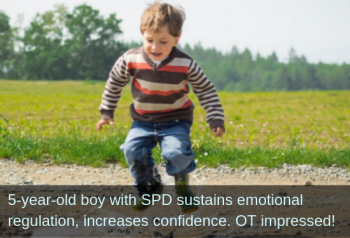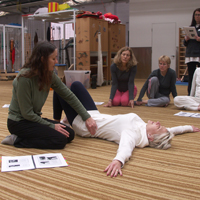5-Year-Old Boy with SPD Sustains Emotional Regulation, Increases Confidence. OT Impressed!
Submitted by T.A. MS, OTR/L Pediatric Occupational Therapist

5 y.o. client with high cognitive functioning presents with [Sensory Processing Disorder] SPD (over-responsive to vestibular, tactile, auditory, visual, olfactory and gustatory). Positive for [primitive reflexes unintegrated] Moro, ATNR, STNR, TLR, Babinksi and Palmar. Started with RM [innate rhythmic movement], FPR tapping sequence, and exercises for Babinski and Palmar [from the Brain and Sensory Foundations, First Level course].
Rapid progress was noted with integration of these reflexes. The first two sessions of FPR tapping he would jump at each tap on his feet and hips, but after that would remain still and reported to enjoy.
Babinski reflex stimulation went from jumping away at stimulus to trace movement of toes and report of “that doesn’t tickle anymore”. Even though he is younger than the suggested age for the isometrics, he seemed to really enjoy the hand and foot exercises.
We created a 5 step plan with a challenging exercise (passing a ball overhead between legs). He frequently lost his balance and would become silly/up-regulated. We went through the 5 step balance [process for goal achievement from the Brain and Sensory Foundations, First level course] with the intention to perform 10 times without loss of balance or regulation. After working on prone ball passing and picking up marbles with toes for balance, [other movements from BSF course] cross crawls and core activation (he really benefits from the isometric proprioception for regulation), he was then able to meet his goal on the first try! He was really proud—he insisted dad come to the session and record his performance!
Prior to this course, we would focus primarily on providing intense heavy work (proprioception) for self-regulation. I would stimulate his nervous system with vestibular input, and immediately follow up with intense proprioception to help modulate the input. Although this worked, it became evident that the heavy work felt like a ‘consequence’; he would try and say he could “control himself this time” (as though it was a behavioral choice vs. a physical reaction). While taking the course, I started following the vestibular input with RM [innate rhythmic movements] and a form of core activation (where he is in quadruped) instead of harder proprioceptive tasks (e.g. wheelbarrow walks, scooter board ramp).
I was impressed that he was able to sustain or regain regulation and moreover, sustain emotional regulation and confidence in himself—not feeling like his silly/hyperactivity was “bad” and that he needed to “control himself”.
He began to see the follow up/regulation activities as a bonding activity and simply a continuation of play.
He does still occasionally need those more intense proprioceptive activities, but it is nice for therapists and parents to have these additional tools in their toolbox.
(Emphasis Added)


